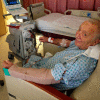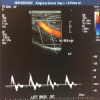Prolonged duration of transbrachial intra-aortic balloon pump as bridge to heart transplantation
- PMID: 25657198
- PMCID: PMC4330429
- DOI: 10.1136/bcr-2014-208658
Prolonged duration of transbrachial intra-aortic balloon pump as bridge to heart transplantation
Abstract
We describe a case demonstrating the quality of life (QOL) benefit and safety of using a transbrachial approach for insertion of an intra-aortic balloon pump (IABP) in a patient awaiting cardiac transplantation. A 68-year-old man with ischaemic cardiomyopathy was admitted to our cardiac intensive care unit to await the availability of a suitable donor organ for orthotopic heart transplant. An IABP was needed for haemodynamic support due to cardiogenic shock. Since the patient did not want to be committed to lying supine in bed for multiple days, as would have been the case had the IABP been placed using the conventional femoral route, we inserted a 7.5 Fr 'sheathless' IABP via the transbrachial approach. The patient's haemodynamics improved and the device was left in place for 240 h without vascular compromise. He was subsequently successfully transplanted and is doing well on follow-up.
2015 BMJ Publishing Group Ltd.
Figures
References
Publication types
MeSH terms
LinkOut - more resources
Full Text Sources
Other Literature Sources
Medical



